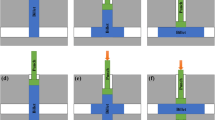Abstract
A new approach to calculating the strain after equal-channel angular pressing is proposed. It is based on the kinematics of material points traveling along physical mass-transfer trajectories. Formulas for determining the accumulated strain and its shear and rotation (torsion) components are derived. The strain component distribution is found as a function of the cross section of a workpiece and the angle of the channel intersection in a die is established. The calculation results are verified.





Similar content being viewed by others
Notes
More complex tensors, which characterize the gradients of the components of these vectors, are used to account for large material particle displacements and rotation vectors [11].
G.I. Raab and A.G. Raab, “Method for producing ultrafine-grained semifinished products by drawing and torsion,” RF Patent 2 347 632.
ECAP refers to a plane strain [4]. In the case of volume SPD, one should use spherical coordinates to describe the trajectory length as a function of the radius vector and the zenith and azimuthal angles of its rotation.
REFERENCES
R. Z. Valiev, A. P. Zhilyaev, and T. G. Langdon, Bulk Nanostructured Materials: Fundamentals and Applications (Wiley, 2013).
F. Z. Utyashev, Modern Severe Plastic Deformation Techniques (Gos. Aviat. Tech. Univ., Ufa, 2008).
R. A. Andrievskii and A. M. Glezer, “Strength of nanostructures,” Usp. Fiz. Nauk 179 (4), 337–358 (2009).
V. M. Segal, V. I. Reznikov, V. I. Kopylov, D. A. Pavlik, and V. F. Malyshev, Plastic Structure Formation of Metals (Navuka Tekhhika, Minsk, 1994).
V. M. Segal, “Materials processing by simple shear,” Mater. Sci. Eng. A. 197 (2), 157–164 (1995).
Y. Iwahashi, J. Wang, Z. Horita, M. Nemoto, and T. G. Langdon, “Principle of equal-channel angular pressing for the processing of ultra-fine grained materials,” Scr. Mater. 35 (2), 143–146 (1996).
G. I. Raab, “Development of scientific foundations for severe plastic deformation techniques and development of equipment for equal-channel angular pressing for production of semifinished products,” Extended Abstract of Doctoral (Eng.) Dissertation (Gos. Aviat. Tech. Univ., Ufa, 2009).
V. L. Kolmogorov, Mechanics of Metal Forming (Metallurgiya, Moscow, 1986).
L. I. Sedov, Mechanics of Continuous Medium (Nauka, Moscow, 1976), Vol. 1.
R. De Vitt, Continuum Theory of Disclinations (Mir, Moscow, 1977).
B. V. Kucheryaev, Mechanics of Continuous Media (MISiS, Moscow, 1999).
V. V. Rybin, Severe Plastic Deformation and Fracture of Metals (Metallurgiya, Moscow, 1986).
F. K. G. Odqvist, Mathematical Theory of Creep and Creep Rupture (Oxford Clarendon Press, Oxford, 1974).
G. A. Smirnov-Alyaev, Resistance of Materials to Plastic Deformation (Mashinostroenie, Leningrad, 1978).
F. Z. Utyashev and G. I. Raab, Deformation Techniques for the Production and Processing of Ultrafine-Grained and Nanostructured Materials (Gilem, Ufa, 2013).
F. Z. Utyashev, “Features of severe plastic deformation and metal structure formation,” S.-Peterb. Nauchno-Tekh. Vedomosti. Fiz.-Mat. Nauki 182 (4–1), 204–212 (2013).
M. Ya. Vygodskii, Advanced Mathematics Handbook (Astrel’, Moscow, 2006).
Zh. Fridel’, Dislocations (Mir, Moscow, 1967).
J. Martin and R. Doherti, Stability of the Microstructure in Metallic Systems (Atomizdat, Moscow, 1978).
V. V. Rybin, “Regularities of formation of mesostructures during developed plastic deformation,” Vopr. Materialoved. 29 (1), 11–33 (2002).
A. P. Zhilyaev, M. D. Baro, Z. Khorita, Dzh. Shpunar, and T. J. Langdon, “Microstructure and grain-boundary spectrum of ultrafine-grained nickel produced by severe plastic deformation,” Russ. Metall. (Metally), No. 1, 60–74 (2004).
F. Z. Utyashev and G. I. Raab, “Effect of the deformation zone on the structure refinement in metals,” Phys. Met. Metallogr. 104 (6), 582–594 (2007).
D. A. Hughes and N. Hansen, “Microstructure and strength of nickel at large strains,” Acta Mat., 48, 2985–3004 (2000).
V. I. Chuvel’diev, O. E. Pirozhkova, M. Yu. Gryaznov, et al., Nano- and Microcrystalline Materials Prepared by Severe Plastic Deformation. Structure. Properties and Application: A Handbook (Lobachevskii Gos. Univ., Nizhny Novgorod, 2006).
A. A. Il’yushin, Mechanics of Continuous Media (Gos. Univ., Moscow, 1990).
G. E. Kodzhaspirov, A. I. Rudskoi, and V. V. Rybin, Physical Foundations and Resource-Saving Technologies for the Manufacture of Products by Plastic Deformation: A Handbook (Gos. Politech. Univ., St. Petersburg, 2006).
M. A. Shtremel’, Strenghth of Alloys, (MISiS, Moscow, 1997), Ch. 1.
F. Z. Utyashev, O. A. Kaibyshev, and V. A. Valitov, “Tool for Deformation of Workpieces,” RF Patent 2172350.
O. A. Kaibyshev and F. Z. Utyashev, Superplasticity, Structure Refinement, and Treatment of Hard-to-Deform Alloys (Nauka, Moscow, 2002).
F. Z. Utyashev, G. I. Raab, V. I. Shibakov, and M. M. Ganeev, The Theory and the Application of Deformation Techniques for the Nanocrystalline Structure Formation in Metals and Alloys (Kazanskii Univ., Kazan’, 2017).
G. I. Raab, D. V. Gunderov, L. N. Shafigullin, Yu. M. Podrezov, M. I. Danylenko, N. K. Tsenev, R. N. Bakhtizin, G. N. Aleshin, and A. G. Raab, “Structural variation in low-carbon steel under severe plastic deformation by drawing, free torsion, and drawing with shear,” Mater. Phys. Mech. 25, 77–82 (2015).
ACKNOWLEDGMENTS
This work was performed within the state assignment of the Institute for Metals Superplasticity Problems of the Russian Academy of Sciences and supported in part by the Russian Foundation for Basic Research, project no. 16-02-00094.
Author information
Authors and Affiliations
Corresponding author
Additional information
Translated by T. Gapontseva
Rights and permissions
About this article
Cite this article
Utyashev, F.Z., Valiev, R.Z., Raab, G.I. et al. Strain Accumulated during Equal-Channel Angular Pressing and Its Components. Russ. Metall. 2019, 281–288 (2019). https://doi.org/10.1134/S0036029519040311
Received:
Revised:
Accepted:
Published:
Issue Date:
DOI: https://doi.org/10.1134/S0036029519040311




